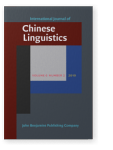Vol. 6:2 (2019) ► pp.260–324
A construction-based account of the synchrony and diachrony of the Chinese middle construction
Chinese middle construction (Chinese MC) uses the form ‘N+V+qilai+C’ to express passive meaning. This study has shown that Chinese MC’s internal connections can be reflected by its synchronic hierarchy. Chinese MC expands horizontally through argument structure and vertically through semantics and its expansion mechanism can be explained by the varying abstraction model of categorization which combines the prototype and the exemplar model. This study has also validated the truth that Chinese MC is a concept encompassing unclear boundaries within its members by using the schematic network model which is the combination of the radial set model and the overlapping set model to represent the internal connections of Chinese MC. By connecting Chinese MC with patient-subject sentences, this study has shown that the expansion of Chinese MC is affected by other structures. Finally, this study has unveiled the affinity between constructionalization and grammaticalization by examining how Chinese MC relates to V-qilai’s grammaticalization.
Article outline
- 1.Introduction
- 1.1Chinese middle construction
- 1.2The criteria to identify Chinese MC
- 1.3The relationship between Chinese middle construction and V-qilai constructions containing an additional complement
- 1.4The syntax and semantics of the Chinese middle construction
- 1.5The research objective and the organization of this study
- 2.Previous accounts of Chinese middle construction
- 2.1Synchronic research on Chinese middle construction
- 2.2Diachronic research on Chinese middle construction
- 3.Data sources and methodology
- 4.Construction-based account of the Chinese middle construction
- 4.1The synchronic organization of the Chinese middle construction
- 4.1.1The taxonomy of Chinese middle verbs
- 4.1.1.1The argument structure of Chinese middle verbs
- 4.1.1.2The semantics of Chinese middle verbs
- 4.1.1.3The eventuality types of Chinese middle verbs
- 4.1.2The hierarchy of Chinese middle construction
- 4.1.3The difference between typical Chinese middle construction and peripheral Chinese middle construction
- 4.1.1The taxonomy of Chinese middle verbs
- 4.2The diachronic development of the Chinese middle construction
- 4.2.1A brief history of the Chinese middle construction
- 4.2.2The expansion mechanisms of the Chinese middle construction
- 4.2.2.1Prototype model and exemplar model
- 4.2.2.2The varying abstraction model of categorization
- 4.2.3The internal connections of the Chinese middle construction
- 4.2.3.1The overlapping sets model and the radial set model
- 4.2.3.2The schematic network model
- 4.2.4The relationship between Chinese middle construction and patient-subject sentences
- 4.2.5The relationship between Chinese middle construction and V-qilai’s grammaticalization
- 4.1The synchronic organization of the Chinese middle construction
- 5.Conclusion
- Notes
- Abbreviations
-
References
